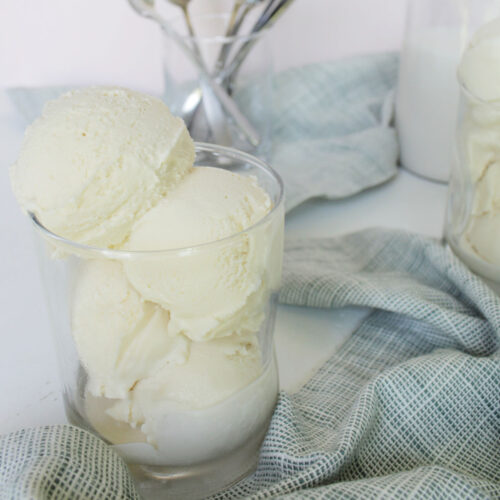This article will teach you the best way to store ice cream in your home freezer. Learn helpful tips and tricks for preventing freezer burn, maintaining the creamy texture, and the science behind keeping ice cream products tasting delicious. There are many secrets for storing both homemade and grocery store ice cream. You'll be amazed at just how long your ice cream will last with a little bit of science and knowledge behind this delicious treat!

Want To Save This Article?
Enter your email below and we'll send it straight to your inbox. Plus, you'll receive new weekly recipe inspiration.
Jump to:
Ice cream is a sweet treat we all love! No matter your favorite type of ice cream or the unique flavors you eat, you'll learn the best way to store it in your home freezer so it lasts!
Believe it or not, there is some science behind storing ice cream for the best taste, creaminess, and optimal freshness. Dive into this article to learn all about it.
How Long Does Ice Cream Last?
Experts recommend that store-bought ice cream lasts around 2 months. Homemade ice cream has a slightly shorter life of around 2-3 weeks.
The most common difference between fresh ice cream and old ice cream is the texture.
Theoretically, ice cream stored in a freezer with constant temperatures of 0°F (-18°C) or colder should keep a high quality, creamy texture. However, the problem comes when we take the ice cream out of that cold environment to scoop and serve it.
Every time ice cream is removed from the freezer, the ice crystals formed during the churning and freezing process start to melt. These tiny crystals form together into larger crystals, leading to an unpleasant, hard texture in the ice cream.
Keep reading to learn even more about the science of ice crystals.

Can Ice Cream Go Bad?
The short answer - Yes. Ice cream can go bad. Here are common signs to look for that your ice cream should be thrown away:
- The top of the ice cream is covered in tiny ice shards.
- There are large, solid frozen masses throughout the ice cream.
- The texture is gummy, sticky, or stringy.
- There is an unpleasant odor.
- There is discoloration of the ice cream.
- The texture appears hard, crunchy, or unpleasant.
- If the ice cream has been left at room temperature and has completely thawed, discard immediately for safety reasons. There could be a potential risk of harmful bacteria growth.
All ice cream stored for a long time will eventually deteriorate over time. There's only a short time that the ice cream will be at its peak of freshness. Keep this in mind when you go to purchase a container of ice cream.

The Best Way To Store Ice Cream
Whether you're storing store-bought or homemade ice cream, here is the best way to keep your ice cream fresh:
- Always store in the back of your freezer. Home freezers do not maintain the recommended steady temperature of 0°F (-18°C) or colder like most commercial freezers can. To help combat this, store the ice cream in the back (not in the freezer door). If you have a chest freezer, store in the bottom, coldest part of the freezer.
I'd recommend purchasing a freezer thermometer to ensure your freezer is at the right temperature for storing ice cream. - Always keep the ice cream container lid firmly in place. You can press a piece of plastic wrap or wax paper on the surface of the ice cream to inhibit the formation of ice crystals and prevent freezer burn.
- After scooping ice cream, immediately return the entire carton to the freezer. This will extend the shelf life of the ice cream and preserve the creamy texture.

The Science Behind Storing Ice Cream
In order to keep the texture of the ice cream tasting super creamy (the way ice cream should be), how you store it is very important.
Ice cream is made up of ice crystals. Essentially, ice crystals give the ice cream some hardness and density so it's not a soupy mess when you eat it.
Ice crystals are created during the churning process. Ice cream makers become super cold and churn the ice cream base along the sides of the cold machine to form the ice crystals. The main goal during the ice cream making process is to keep the ice crystals small so you end up with smooth ice cream.
After the ice cream is churned, the goal is to keep the tiny ice crystals that were formed. Any time the ice cream melts, the ice crystals mold together. This creates larger ice crystals that lead to more grainy ice cream and an icy mess.
This is why it's always a good idea to store the ice cream in the back of the freezer. So you can maintain a cold environment for the ice crystals to stay small.

Frequently Asked Questions About Storing Ice Cream
While the ideal temperature for scooping ice cream is around 6°F and 10°F, thawing the entire ice cream container to this temperature can have a negative effect on the quality of the ice cream that remains after you serve.
During the refreezing process, the ice crystals mold together to form larger masses. This is what causes a grainy texture to form in the ice cream. Ice cream experts would suggest that you do not thaw and then refreeze an entire container of ice cream.
Yes! Always keep an eye out for the expiration date listed on the ice cream container. You can expect grocery store ice cream to last about 2 months, and homemade ice cream to last for 2-3 weeks.
The best type of storage container for ice cream is something that helps the ice cream freeze quickly. This is especially important if you're making homemade ice cream. A skinny, airtight container will help homemade ice cream freeze fairly quickly and maintain the tiny ice crystals that were created during the churning process.
For store-bought ice cream, keep it in the original container you purchased it in.
The typical shelf life of commercial ice cream is around 2 months. Homemade ice cream lasts about 2-3 weeks. You'll most noticeably be able to tell the ice cream has gone bad by observing how it looks. Ice cream with large ice chunks or crystals is a sign you should throw it out. If your ice cream appears sticky or gummy (rather than creamy), it has gone bad.
The best place to store ice cream is in the back of your freezer (not in the freezer door) in order to keep it at a stable temperature. The freezer's temperature should ideally be around 0°F (-18°C) or colder. You can purchase a freezer thermometer to check the temperature, and adjust your freezer dial accordingly.
Homemade Ice Cream Recipes
If you love ice cream, try making your own at home with an ice cream maker. These are some great recipes to start with:
Plus, don't forget to check out these 30+ ice cream maker recipes.










Lee
Thanks for including information about the science on this article. Super informative and helpful.